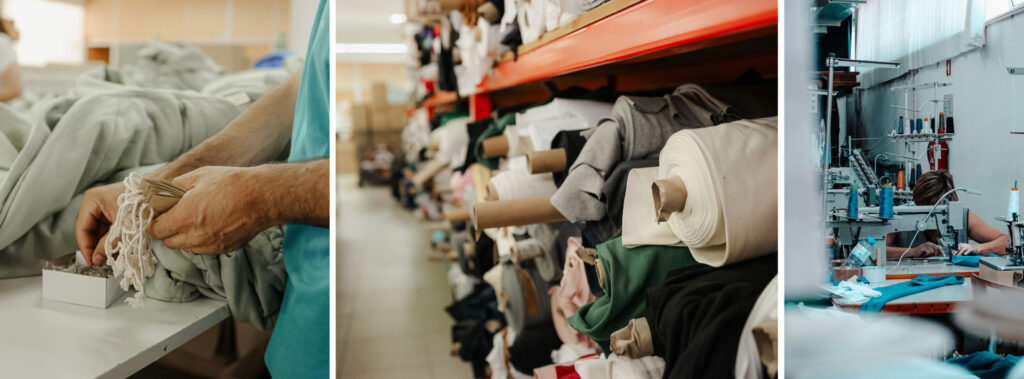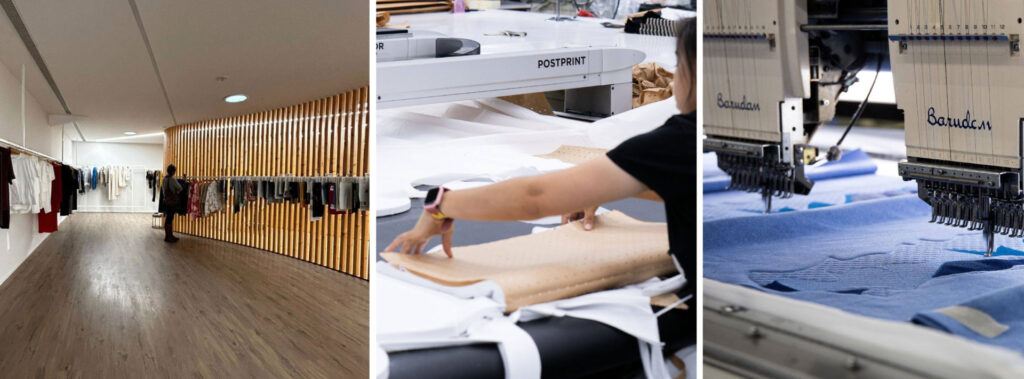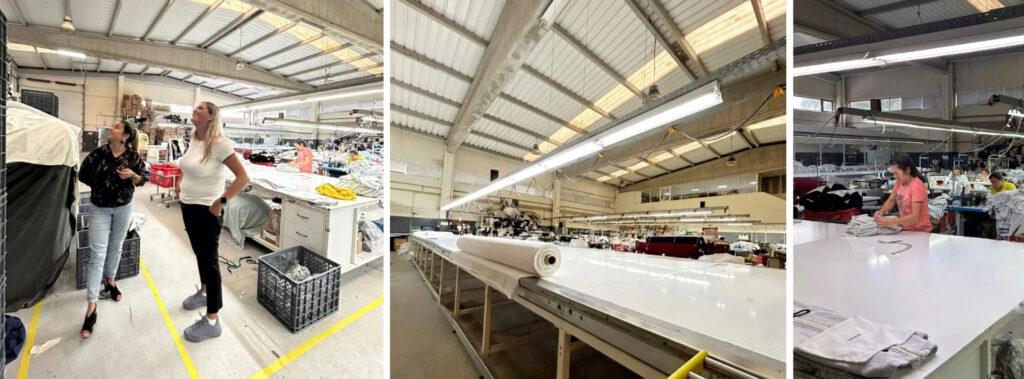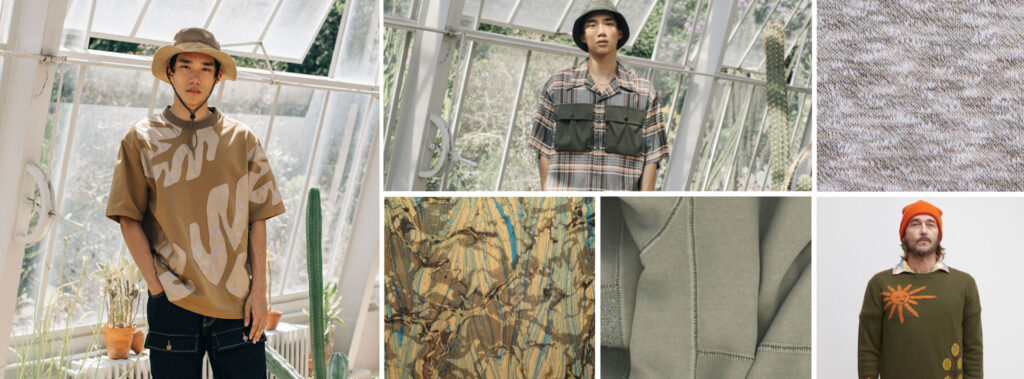Discover how fashion brands choose the right jersey knit (from fiber type and GSM to sustainable sourcing and production) with Deepwear’s global textile experts.
When Coco Chanel began using jersey in her collections in the early 1900s, she wasn’t following fashion — she was rewriting it. At the time, jersey was an unglamorous textile associated with men’s underwear and workwear. But Chanel saw something others didn’t: its softness, stretch, and natural drape embodied freedom of movement — a radical idea for women’s fashion then defined by corsets and stiff tailoring.
She turned a humble knit into a symbol of modern comfort and independence, cutting her dresses, skirts, and blouses from jersey that moved with the body instead of against it. More than a century later, that same principle drives the global demand for jersey — now made in cotton, wool, viscose, bamboo, and recycled blends — across everything from luxury ready-to-wear to sustainable basics.
In this blog we cover:
- What jersey really is and common knit types
- Global fabric suppliers: key countries, GSM ranges, and garment applications
- How to match jersey’s properties to your brand’s design, function, and scale
- Tips for balancing quality, cost, and sustainability with Deepwear’s sourcing network

What Jersey Really Is
Though often described as a fabric, jersey is technically a knit structure, not a fiber. Its defining characteristic lies in how it’s made — through a single set of interlooped yarns that create stretch, recovery, and a smooth surface. This construction makes the jersey naturally elastic, breathable, and soft to the touch, ideal for clothing that flatters movement.
Depending on the yarn and weight, jersey can feel light and fluid or thick and sculpted, giving designers flexibility much like other fabrics discussed in our guide to eco-friendly natural fabrics.
Common Types of Jersey
- Single Jersey – Fine, stretchy, and soft. Commonly used for t-shirts and dresses.
- Double Jersey – Heavier with balanced stretch. Great for structured tops, skirts, and suiting.
- Interlock Jersey – Smooth on both sides, durable, and opaque. Perfect for uniforms and athleisure.
- Stretch/Spandex Jersey – Highly elastic. Ideal for activewear and lingerie.
- Viscose/Bamboo/Modal Jersey – Luxurious drape with a silky touch. Often used in eco-conscious or premium collections.

Jersey Fabric Sourcing Across Deepwear Office Countries
Jersey isn’t limited to wool anymore. Mills around the world now produce jerseys from cotton, modal, viscose, bamboo, and recycled synthetics, allowing brands to select the ideal type for their garment’s function — from lightweight T-shirts to structured loungewear or designer pieces. Below is an overview of key sourcing countries, highlighting fabric weight, garment applications, and production strengths.
1. Thailand: Thailand specializes in light to midweight jerseys (120–240 GSM) suitable for a variety of garments. Lighter weights are excellent for breathable T-shirts, uniforms, and summer tops, while midweights are great for polos, casual dresses, or slightly structured tops. Thai mills are known for flexible sampling and skilled knit production, making them ideal for both emerging and established brands.
- Colors: Solid-dyed, melange, heather, yarn-dyed options
- MOQ & Yardage: 100–500 meters per color; 5–20 meters for sampling
2. India: Indian manufacturers produce jerseys in 140–300 GSM, including single jersey, interlock, and rib. Lighter jerseys are perfect for casual tops and lightweight dresses, while heavier options work well for hoodies, structured loungewear, or layered pieces. India is also highly flexible with fiber types, offering cotton, organic cotton, modal, and viscose options.
- Colors: Reactive and pigment-dyed, digital printing, GOTS-certified organic dyes
- MOQ & Yardage: 100–500 meters per color; 5–10 meters for sample yardage
3. Vietnam: Vietnamese mills focus on stretch and performance jerseys (130–280 GSM). Lightweight fabrics are ideal for activewear tops and yoga apparel, while heavier jerseys provide support and structure for athleisure or fitted garments. Vietnam is particularly strong in technical and performance fabrics.
- Colors: Solid, printed, moisture-wicking, brushed finishes
- MOQ & Yardage: 100–500 meters per color

4. China:China offers a broad range of jersey fabrics, 120–300 GSM, suitable for everything from light tees to heavy sweatshirts. With strong mass production capabilities, China is ideal for brands requiring high-volume orders.
- Colors: Pantone-matched solids, prints, sublimation
- MOQ & Yardage: 500–1,000 meters common for dyed fabrics; 5–10 meters sample yardage
5. Turkey: Turkey excels at European-standard cotton and rib jerseys (140–280 GSM). Lighter weights are used for base layers and T-shirts, while heavier fabrics suit structured tops and jackets. Fast lead times to the EU make Turkey a reliable European partner.
- Colors: Yarn-dyed, solid, melange, pigment-dyed
- MOQ & Yardage: 50–300 meters per color
6. Portugal: Portugal’s jerseys range from 150–320 GSM, ideal for sustainable or luxury small-batch production. Lighter fabrics suit premium T-shirts and resort wear, while denser jerseys are used for structured loungewear and minimalist fashion.
- Colors: Solid, garment-dyed, brushed, specialty finishes
- MOQ & Yardage: 50–300 meters
7. Italy: Italy produces premium jerseys (160–340 GSM) perfect for designer tops, dresses, and sculptural knitwear. Known for luxury finishing and craftsmanship, Italian fabrics are often chosen for high-end collections.
- Colors: Yarn-dyed, reactive dyes, luxury finishing
- MOQ & Yardage: 100–300 meters
8. Spain: Spain supplies jerseys between 140–280 GSM, balancing cost, quality, and reliability. Lighter fabrics suit digitally printed tops, heavier ones are used for casual dresses or light sweaters.
- Colors: Reactive dyes, enzyme finishes, digital prints
- MOQ & Yardage: 50–300 meters

9. Morocco: Moroccan mills produce 130–280 GSM jerseys, with both garment-dyed and solid options. Lighter fabrics are used for basic apparel, heavier ones for streetwear or lounge sets.
- Colors: Solid or garment-dyed; digital print for export quality
- MOQ & Yardage: 100–500 meters
10. Bulgaria: Eastern European jerseys (150–280 GSM) are cost-effective and suited for mid-volume production. Light fabrics work for everyday tops, while midweights are great for sweatshirts and fitted garments.
- Colors: Solid, pigment-dyed, yarn-dyed
- MOQ & Yardage: 100–300 meters
11. USA / Australia: USA and Australia offer small-batch artisan jersey mills (140–320 GSM). Lighter fabrics suit independent label basics, heavier ones for premium sweatshirts or local capsule collections emphasizing traceability and craftsmanship.
- Colors: Solid and printed, small-batch artisan mills
- MOQ & Yardage: 10–100 meters
Disclaimer: GSM ranges and MOQs above are indicative averages and can vary by fiber type, yarn composition, finishing method, certification (GOTS, OEKO-TEX, etc.), and colorway volume.
Why Deepwear’s Local Offices Matter
Working with jersey mills across multiple countries is easier — and more reliable — when you have people on the ground. Deepwear’s global sourcing offices in these key sourcing hubs bridge the gap between brands and factories.
Our teams can handle fabric sampling, supplier vetting, on-site quality checks, and logistics coordination, ensuring that each stage of production meets your standards. This local presence means faster communication, fewer errors, and smoother collaborations from first sample to final shipment.
Looking to source the perfect jersey fabric for your next collection? Deepwear’s consultants can help you compare global mills, test fabric weights, and find sustainable jersey suppliers that match your brand’s design and production goals.

What Is Jersey Fabric and Why Is It Popular in Fashion?
Jersey is a knit structure known for its stretch, softness, and versatility. It adapts to a wide range of garments — from luxury dresses to everyday tees — and supports sustainable sourcing options in cotton, viscose, and recycled fibers. Deepwear helps fashion brands select the right jersey type, GSM, and supplier to balance comfort, durability, and responsible production.
Is Jersey Right for Your Brand?
Choosing jersey for your collection isn’t just about selecting a soft, stretchy knit; it’s also about matching the material properties to your garment’s purpose and your brand’s identity. Here are some key considerations:
- Fiber Type: Cotton jerseys are breathable and versatile, perfect for casual wear or basics. Viscose, bamboo, or modal jerseys offer a luxurious drape and smooth hand-feel, ideal for premium or eco-conscious collections. Blended or recycled jerseys can combine performance with sustainability.
- Knit Structure: Not all knits are jerseys. Single jersey is light and flowy, suited for T-shirts and dresses. Interlock or double jersey adds weight and structure, better for skirts, tops, or loungewear. Stretch jerseys with spandex or elastane are essential for activewear, lingerie, or fitted pieces.
- Weight (GSM): Lighter weights (120–160 GSM) are breathable and comfortable for everyday wear, while midweights (160–250 GSM) provide structure for polos, skirts, or casual jackets. Heavier jerseys (250–340 GSM) create sculptural pieces, outerwear, or structured knitwear.
- Function and Aesthetic: Consider how your garment should move, fit, and feel. Jersey’s elasticity and recovery allow ease of movement, making it ideal for athleisure, T-shirts, dresses, and lounge sets. For tailored looks, heavier or double-knit jerseys offer the control and structure needed.
- Sourcing and Scale: Depending on your production goals, you can choose countries that match your priorities. For small-batch, sustainable, or artisan collections, Portugal, Italy, USA, or Australia may be ideal. For mid- to high-volume runs, China, India, or Vietnam offer competitive pricing and technical capabilities.By understanding these aspects, brands can make informed choices — selecting a jersey that not only fits the design vision but also aligns with cost, scale, and sustainability objectives. Ultimately, the right jersey knit transforms a simple garment into one that is comfortable, functional, and brand-defining, just as Coco Chanel envisioned over a century ago.

Ready to Source Your Perfect Jersey?
Deepwear helps fashion brands navigate the complexities of jersey sourcing — from fiber selection and knit structure to GSM specifications and global manufacturing capabilities. Whether you’re creating small-batch luxury collections or scaling for high-volume production, our network of trusted mills ensures quality, flexibility, and sustainability at every step.
Ready to turn your jersey ideas into high-quality, sustainable collections? Book a strategy call with Deepwear’s sourcing experts or explore our global jersey and knitwear manufacturing network today.